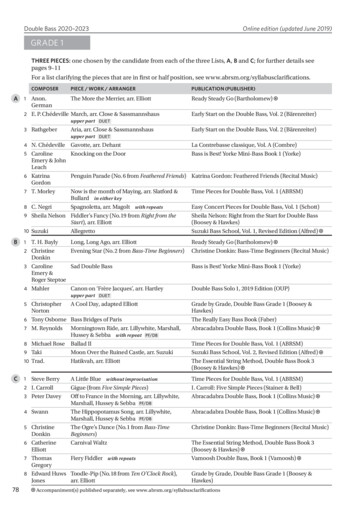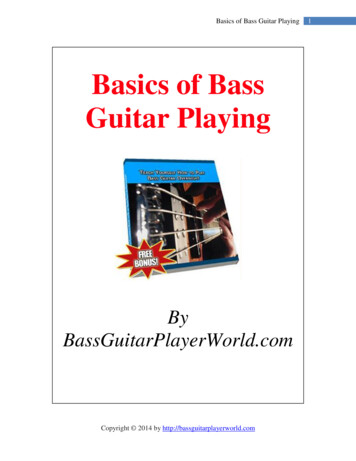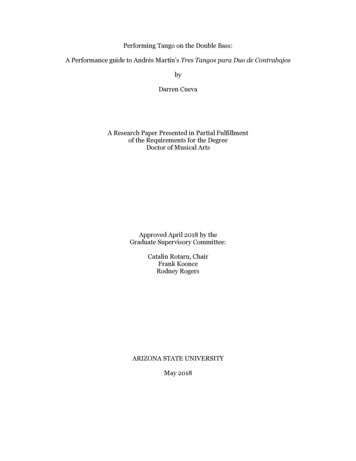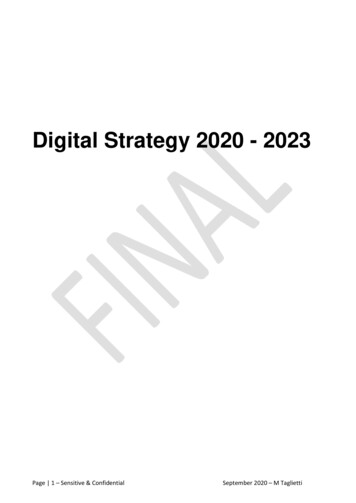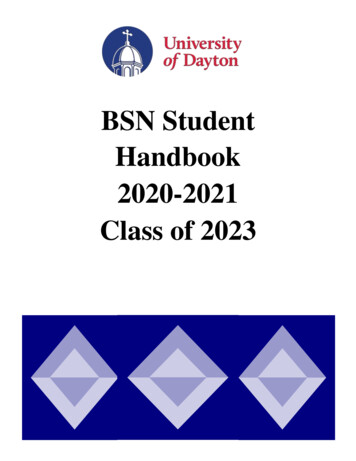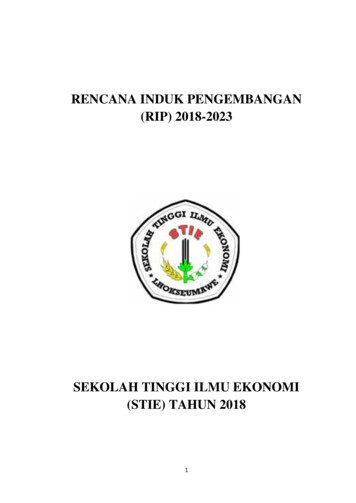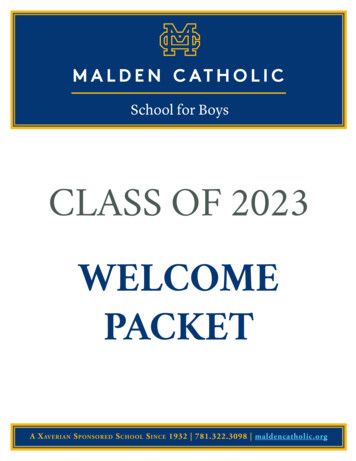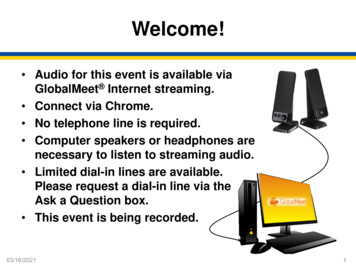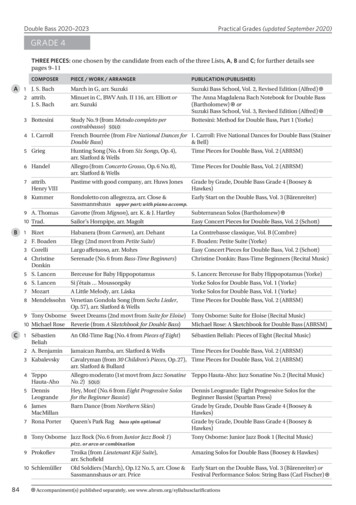
Transcription
Double Bass 2020–2023 Practical Grades (updated September 2020)GRADE 4THREE PIECES: one chosen by the candidate from each of the three Lists, A , B and C; for further details seepages 9–11COMPOSERAPIECE / WORK / ARRANGERPUBLICATION (PUBLISHER)1J. S. Bach2 attrib.J. S. BachMarch in G, arr. SuzukiMinuet in C, BWV Anh. II 116, arr. Elliott orarr. Suzuki3 BottesiniStudy No. 9 (from Metodo completo percontrabbasso) SOLOFrench Bourrée (from Five National Dances forDouble Bass)Hunting Song (No. 4 from Six Songs, Op. 4),arr. Slatford & WellsAllegro (from Concerto Grosso, Op. 6 No. 8),arr. Slatford & WellsPastime with good company, arr. Huws JonesSuzuki Bass School, Vol. 2, Revised Edition (Alfred)The Anna Magdalena Bach Notebook for Double Bass(Bartholomew) orSuzuki Bass School, Vol. 3, Revised Edition (Alfred)Bottesini: Method for Double Bass, Part 1 (Yorke)4 I. Carroll5 Grieg6 Handel7 attrib.Henry VIII8 Kummer9 A. Thomas10 Trad.B1Bizet2 F. Boaden3 Corelli4 ChristineI. Carroll: Five National Dances for Double Bass (Stainer& Bell)Time Pieces for Double Bass, Vol. 2 (ABRSM)Time Pieces for Double Bass, Vol. 2 (ABRSM)Grade by Grade, Double Bass Grade 4 (Boosey &Hawkes)Early Start on the Double Bass, Vol. 3 (Bärenreiter)Rondoletto con allegrezza, arr. Close &Sassmannshaus upper part; with piano accomp.Subterranean Solos (Bartholomew)Gavotte (from Mignon), arr. K. & J. HartleySailor’s Hornpipe, arr. MagoltEasy Concert Pieces for Double Bass, Vol. 2 (Schott)Habanera (from Carmen), arr. DehantElegy (2nd movt from Petite Suite)Largo affetuoso, arr. MohrsSerenade (No. 6 from Bass-Time Beginners)La Contrebasse classique, Vol. B (Combre)F. Boaden: Petite Suite (Yorke)Easy Concert Pieces for Double Bass, Vol. 2 (Schott)Christine Donkin: Bass-Time Beginners (Recital Music)Donkin5 S. LancenBerceuse for Baby HippopotamusSi j’étais Moussorgsky7 MozartA Little Melody, arr. Láska8 Mendelssohn Venetian Gondola Song (from Sechs Lieder,Op. 57), arr. Slatford & Wells9 Tony Osborne Sweet Dreams (2nd movt from Suite for Eloise)10 Michael Rose Reverie (from A Sketchbook for Double Bass)S. Lancen: Berceuse for Baby Hippopotamus (Yorke)Yorke Solos for Double Bass, Vol. 1 (Yorke)Yorke Solos for Double Bass, Vol. 1 (Yorke)Time Pieces for Double Bass, Vol. 2 (ABRSM)1An Old-Time Rag (No. 4 from Pieces of Eight)Sébastien Beliah: Pieces of Eight (Recital Music)Jamaican Rumba, arr. Slatford & WellsCavalryman (from 30 Children’s Pieces, Op. 27),arr. Slatford & BullardAllegro moderato (1st movt from Jazz SonatineNo. 2) SOLOHey, Mon! (No. 6 from Eight Progressive Solosfor the Beginner Bassist)Barn Dance (from Northern Skies)Time Pieces for Double Bass, Vol. 2 (ABRSM)Time Pieces for Double Bass, Vol. 2 (ABRSM)6 S. LancenCSébastienBeliah2 A. Benjamin3 Kabalevsky4 TeppoHauta-Aho5 DennisLeogrande6 JamesMacMillan7 Rona PorterQueen’s Park Rag bass spin optional8 Tony Osborne Jazz Rock (No. 6 from Junior Jazz Book 1)pizz. or arco or combination9 Prokofiev10 Schlemüller84Troika (from Lieutenant Kijé Suite),arr. SchofieldOld Soldiers (March), Op. 12 No. 5, arr. Close &Sassmannshaus or arr. PriceTony Osborne: Suite for Eloise (Recital Music)Michael Rose: A Sketchbook for Double Bass (ABRSM)Teppo Hauta-Aho: Jazz Sonatine No. 2 (Recital Music)Dennis Leogrande: Eight Progressive Solos for theBeginner Bassist (Spartan Press)Grade by Grade, Double Bass Grade 4 (Boosey &Hawkes)Grade by Grade, Double Bass Grade 4 (Boosey &Hawkes)Tony Osborne: Junior Jazz Book 1 (Recital Music)Amazing Solos for Double Bass (Boosey & Hawkes)Early Start on the Double Bass, Vol. 3 (Bärenreiter) orFestival Performance Solos: String Bass (Carl Fischer)Accompaniment(s) published separately, see www.abrsm.org/syllabusclarifications
Practical Grades (updated September 2020) Double Bass 2020–2023 Grade 4SCALES AND ARPEGGIOS: from memory; for further details (including examples) see pages 11, 14–15 & 19 RANGEREQUIREMENTSa 12thseparate bows or slurred (2 quavers to a bow), atexaminer’s choice;even notes or long tonic, at candidate’s choicea 12thseparate bows or slurred (3 notes to a bow), atexaminer’s choice;even notesSCALESE, F, G, A majorsE, G, A minors(harmonic or melodic, at candidate’s choice)ARPEGGIOSE, F, G, A majorsE, G, A minorsDOMINANT SEVENTHS (resolving on tonic)in the keys of A and B -1 oct.separate bows;even notes1 oct.separate bows or slurred (3 notes to a bow), atexaminer’s choice;even notesCHROMATIC SCALESstarting on G and BSIGHT-READING: a short piece of previously unseen music; for further details see pages 12 & 20–21AURAL TESTS: administered by the examiner from the piano; for further details see pages 94 & 9785
Grades Initial–8BOWED STRING PRACTICAL GRADES: requirements and informationThis syllabus is valid for 2020–2023.This section provides a summary of the most important points that teachers and candidatesneed to know when taking ABRSM Practical Grades for bowed string instruments. Furtherdetails, as well as admini strative information about the exams, are given in ABRSM’s ExamRegulations (available at www.abrsm.org/examregulations) which should be read beforemaking an exam booking.Changes in the 2020–2023 syllabusThere are two main changes in this syllabus: Initial Grade is introduced; this pre-Grade 1 exam follows the format of Grades 1–8 and isassessed using the same marking criteriaA string accompaniment option is offered for some pieces at Grades Initial–3.Entering for an examEligibility: There are nine grades of exam for each instrument. Candidates may be entered forany grade at any age and do not need to have taken other grade(s) on the same instrument.Candidates for a Grade 6, 7 or 8 exam must have already passed ABRSM Grade 5 (or above) inMusic Theory, Practical Musicianship or a Practical Grades solo Jazz instrument; for full details,including a list of accepted alternatives, see www.abrsm.org/prerequisite.Access: ABRSM is committed to providing all candidates with fair access to its assessmentsby putting in place access arrangements and reasonable adjustments. There is a range ofalternative tests and formats as well as guidelines for candidates with specific needs (see www.abrsm.org/specificneeds). Where a candidate’s needs are not covered by the guidelines, eachcase is considered individually. Further information is available from the Access Co-ordinator(accesscoordinator@abrsm.ac.uk).Exam booking: Details of exam dates, locations, fees and how to book an exam are availableonline at www.abrsm.org/exambooking.InstrumentsCandidates are required to perform on acoustic instruments (electric instruments are notallowed). Any size of instrument may be used; Viola candidates may play on a violin strungas a viola. Examiners apply the marking criteria (which include the assessment of pitch, toneand musical shaping) to assess musical outcomes without reference to the specific attributesof the instrument.8
Bowed String Practical Grades: requirements and informationElements of the examAll ABRSM Practical bowed string exams consist of: three Pieces; Scales and arpeggios; Sightreading; and Aural tests. In all grades, marks are allocated as follows:Pieces: 123Scales and arpeggiosSight-readingAural testsTotal303030212118150Marking scheme: Exams are marked out of 150. 100 marks are required for a Pass, 120 for aMerit and 130 for a Distinction. Candidates do not need to pass each section to pass overall.See pp. 106–107 for the marking criteria used by examiners.PiecesMusicians learn to play an instrument to explore and perform repertoire, which is why piecesare at the core of the exam – candidates are asked to present three at each grade. The syllabusrepertoire is organised into three lists which explore different traditions and styles, datingfrom the Renaissance period to the present day.Choosing one piece from each list gives candidates the opportunity to play a balancedselection and demonstrate a range of skills. In this syllabus, the pieces are broadly groupedinto lists by the characteristics of the music: List A pieces are generally faster moving and require technical agilityList B pieces are more lyrical and invite expressive playingList C pieces reflect a wide variety of musical traditions, styles and characters.Most of the pieces require an accompaniment, as interacting with other musicians is animportant musical skill, but there are also opportunities to choose solo pieces and developconfidence with unaccompanied playing.We hope that by offering this variety in the syllabus, candidates will find music that inspiresthem and that they enjoy learning and performing.Programme planning: Candidates must choose one piece from each of the three lists (A, Band C)*. In the exam, candidates should tell the examiner which pieces they are performing,and they are welcome to use the form on p. 108 for this.Every effort has been made to feature a broad range of repertoire to suit and appeal tocandidates of different ages, backgrounds and interests. Certain pieces may not be suitable forevery candidate for technical reasons or because of wider context (historical, cultural, subjectmatter of the larger work from which it is drawn, lyrics if an arrangement of a song etc.). Piecesshould be carefully considered for their appropriateness to each individual, which may needconsultation between teachers and parents/guardians. Teachers and parents/guardians shouldalso exercise caution when allowing younger candidates to research pieces online: www.nspcc.org.uk/onlinesafety.* Grade 8 Violin candidates must choose at least one accompanied piece (there are solo pieces on all three lists).9
Bowed String Practical Grades: requirements and informationThe repertoire lists are the same as for ABRSM Performance Grades. Candidates may not presentthe same repertoire (in full or individual pieces) for the same grade of both qualifications,irrespective of when the exams are taken.Accompaniment: A live piano or string (where the option is listed) accompaniment is requiredfor all pieces, except those which are published as studies or unaccompanied works (these aremarked SOLO in the syllabus list).At Grades Initial–3, candidates may perform some or all of their pieces with a string accompaniment. Pieces that are published as duets (or with string accompaniment only) are marked DUETin the syllabus list. Pieces that are published with piano and string accompaniment options aremarked PF/VN , PF/VA , PF/VC , or PF/DB in the syllabus list, and may be performed with eitheraccompaniment in the exam.Candidates must provide their own accompanist(s), who can only be in the exam room whileaccompanying. The candidate’s teacher may accompany (examiners will not). If necessary,an accompanist may simplify any part of the accompaniment, as long as the result is musical.Recorded accompaniments are not allowed.Exam music & editions: Wherever the syllabus includes an arrangement or transcription(appearing as ‘arr.’ or ‘trans.’ in the syllabus list), the edition listed in the syllabus must be usedin the exam. For all other pieces, editions are listed for guidance only and candidates may useany edition of their choice (in- or out-of-print or downloadable). Information on sourcing exammusic is given on p. 13.Interpreting the score: Printed editorial suggestions such as fingering, bowing, metronomemarks, realisation of ornaments etc. do not need to be strictly observed. Whether the piececontains musical indications or not, candidates are encouraged to interpret the score in amusical and stylistic way. Examiners’ marking will be determined by how control of pitch, time,tone, shape and performance contributes to the overall musical outcome.Vibrato: The use and control of vibrato, and its effect on tone and shape, will be taken intoaccount by examiners, who will be assessing the overall musical outcome. Pieces that areheavily reliant on vibrato for their full musical effect tend not to appear in the syllabus beforearound Grade 5.Repeats: Unless the syllabus specifies differently, all da capo and dal segno indications shouldbe followed but other repeats (including first-time bars) should not be played unless they arevery short (i.e. a few bars).Cadenzas & tuttis: Cadenzas should not be played unless the syllabus specifies differently.Accompanists should cut lengthy orchestral tutti sections.Performing from memory: Candidates may perform any of their pieces from memory; if doingso, they must make sure that a copy of the music is available for the examiner to refer to. Noextra marks are awarded for playing from memory.Page-turns: Examiners will be understanding if a page-turn causes a lack of continuity during apiece, and this will not affect the marking. Candidates (and accompanists) may use an extra copyof the music or a photocopy of a section of the piece (but see ‘Photocopies’ on p. 11) to help withpage-turns. Candidates and accompanists at Grades 6–8 may bring a page-turner to the examif there is no solution to a particularly awkward page-turn (prior permission is not required;the turner may be the candidate’s teacher). Examiners are unable to help with page-turning.10
Bowed String Practical Grades: requirements and informationPhotocopies: Performing from unauthorised photocopies (or other kinds of copies) or illegaldownloads of copyright editions is not allowed. ABRSM may withhold the exam result where ithas evidence of an illegal copy (or copies) being used. In the UK, copies may be used in certainlimited circumstances – for full details, see the MPA’s Code of Fair Practice at www.mpaonline.org.uk. In all other cases, application should be made to the copyright holder before any copyis made, and evidence of permission should be brought to the exam.Scales and arpeggiosPlaying scales and arpeggios is important for building strong technical skills such as reliablefinger movement, hand position, co-ordination and fingerboard fluency. It also helps todevelop tone, pitch and interval awareness, and familiarity with keys and their rel
10 Michael Rose Reverie (from A Sketchbook for Double Bass) Michael Rose: A Sketchbook for Double Bass (ABRSM) 1 Sébastien Beliah An Old-Time Rag (No. 4 from Pieces of Eight) Sébastien Beliah: Pieces of Eight (Recital Music) 2 A. Benjamin Jamaican Rumba, arr. Slatford & Wells Time Pieces for Double Bass, Vol. 2 (ABRSM)
